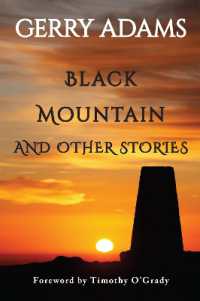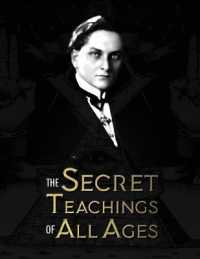- ホーム
- > 洋書
- > 英文書
- > Religion / Ethics
基本説明
Reconstructs a single original African source for our collective myths, dating back some 100,000 years.
Full Description
This remarkable book is the most ambitious work on mythology since that of the renowned Mircea Eliade, who all but single-handedly invented the modern study of myth and religion. Focusing on the oldest available texts, buttressed by data from archeology, comparative linguistics and human population genetics, Michael Witzel reconstructs a single original African source for our collective myths, dating back some 100,000 years. Identifying features shared by this "Out of Africa" mythology and its northern Eurasian offshoots, Witzel suggests that these common myths-recounted by the communities of the "African Eve"-are the earliest evidence of ancient spirituality. Moreover these common features, Witzel shows, survive today in all major religions. Witzel's book is an intellectual hand grenade that will doubtless generate considerable excitement-and consternation-in the scholarly community. Indeed, everyone interested in mythology will want to grapple with Witzel's extraordinary hypothesis about the spirituality of our common ancestors, and to understand what it tells us about our modern cultures and the way they are linked at the deepest level.
Contents
1.1 ; What is myth, how do we study and compare it? ; 1.2 ; Definition; study of myth in the past (from Vico to Levi-Strauss) ; 1.3 ; Comparative mythology ; 1.4 ; A new proposal: Laurasian mythology ; 1.5 ; Earlier explanations of myth ; 1.6 ; Ur-forms, history, and archaeology ; 1.7 ; Summary ; 2 Comparison and Theory ; 2.1 ; Theory and practice of comparisons ; 2.2 ; Reconstructing Laurasian mythology ; 2.2.1 ; Similarities ; 2.2.2. ; Regular correspondences and establishment of a unified narrative scheme ; 2.2.3 ; Oldest texts are to be used ; 2.2.4 ; Geographically dispersed items ; 2.2.5 ; Reconstruction of the Laurasian Common Story line and individual myths ; 2.3 ; Enhancing the reconstruction: local, regional, macro-regional, and subcontinental variations ; 2.4 ; Reconstructing the Laurasian mythological system and its problems ; 2.5 ; Structure and content in some Macro-areas of Laurasian Myth. ; 2.5.1 ; Macro-areas ; 2.5.2 ; The Four ages in the Eurasian and Meso-American macro-areas ; 2.5.3 ; Later centers of innovations ; 2.5.4. ; Late Borrowings ; 2.6. ; Some objections to the approach of historical comparative mythology ; 3 Creation Myths : The Laurasian story line: our first novel ; 3.1 ; Creation from: ; 1. Chaos 2. Water 3.Earth diver/Floating earth ; 4. Giant 5. Bull 6. Egg 7. Combined versions ; 3.2 ; Father Heaven, Mother Earth ; 3.3 ; Separation of heaven and earth, the prop ; 3.4. ; Creation of land ; 3.5 ; The demiurge/ trickster ; 3.5.1 ; Creation of Light ; 3.5.2. ; The slaying of the dragon ; 3.5.3 ; The theft of fire /heavenly drink ; 3.6 ; Generations, four ages and five suns ; 3.7 ; The creation of humans ; 3.8 ; Descent of noble lineages ; 3.9 ; The flood ; 3.10 ; Heroes ; 3.11 ; The final destruction ; 3.12 ; Summary ; 4 ; The contributions of other sciences ; 4.1. ; Linguistics ; 4.2 ; Physical anthropology ; 4.3. ; Genetics ; 4.3.1 ; Recent advances in human population genetics ; 4.3.2 ; Out of Africa ; 4.3.4 ; Movement northward after the last two Ice Ages ; 4.3.5 ; Genetics, language and mythology ; 4.4. ; Archaeology ; 4.4.1 ; Cave Paintings and Plastic Art ; 4.4.2 ; Sacrifice in Late Palaeolithic Art ; 4.4.3 ; Food production ; 4.4.4 ; Domestic animals and pastoralism ; 4.5 ; Other items of comparison ; 4.6. ; Conclusions resulting from the comparison of the sciences involved ; 5 ; The countercheck: Australia, Melanesia, sub-Saharan Africa ; 5.1 ; Possible counterchecks and falsification ; 5.1.1 ; Method ; 5.1.2 ; Criteria for falsification ; 5.1.3 ; Diffusion vs genetic relationship ; 5.1.4 ; Later additions ; 5.2 ; Beyond Laurasia: Gondwana mythology ; 5.3. ; Gondwana mythologies ; 5.3.1 ; Sub-Saharan Africa, the Andamans, New Guinea, Australia and Tasmania ; 5.3.2 ; Australia ; 5.3.2.1 ; Tasmania ; 5.3.3. ; Melanesia ; 5.3.3.1 Negritos and other Southern remnant populations ; 5.3.4 ; Andaman Islands ; 5.3.5 ; Africa ; 5.3.5.1 Remnant populations: San and Pygmies ; 5.3.5.2 Sub-Saharan Africa ; 5.3.5.3 ; Northern influences: the Western N.-S. Highway ; 5.3.5.4 The eastern North-South Highway ; 5.3.6 ; Summary ; 5.4. ; Individual Gondwana myth types and their common characteristics ; 5.5 ; Secondary influences on Gondwana mythology ; 5.6. ; Conflicting myths in Gondwanaland ; 5.6.1 ; Gondwana element in Laurasian myth ; 5.6.2 ; Laurasian elements in Gondwana myth ; 5.7 ; Countercheck, falsification of Laurasian mythology based on Gondwana mythology ; 5.7.1 ; Essential features of Gondwana and Laurasian mythology ; 5.7.2 ; The flood myth in world wide perspective ; 6 First Tales: pan-Gaean mythology ; 6.1 ; Beyond Laurasia and Gondwana: common myths ; 6.2 ; Our first tales ; 7 Laurasian mythology in historical development ; 7.1.1 ; Late Palaeolithic shamanism ; 7.1.2 ; Sacrifice ; 7.2. ; Changes from Palaeolithic to state societies ; 7.3. ; Dating Gondwana and Laurasian mythology ; 8 Outlook ; 8.1 ; The Meaning of Laurasian Mythology ; 8.2 ; Beyond Laurasia, Gondwana and Pan-Gaia ; 8.2.1 ; Persistence of myth ; 8.2.2 ; Some reasons ; 8.3. ; Epilogue







